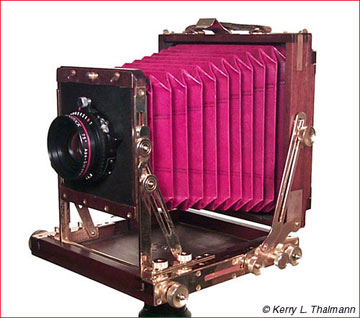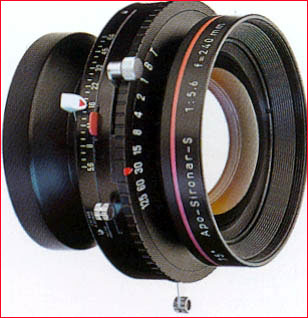Choosing A First Lens for Large Format
A few years ago, inPhoto Techniques, I published an article by Carl Weese about using a digital camera as a tool for large-format photographers. Carl made a great case, and it still seems like a good idea to me. I think it works well the other way around, too — not only is a digicam a good adjunct to a big camera for dedicated LF shooters, but a large-format camera is a nice occasional change of pace for somebody who shoots mostly digital. I mention all this because I was asked last week what focal length would be a good first choice for a mainly digital shooter wanting to get into large format.

A nice (and inexpensive) Anba Ikeda 4×5. Photo courtesy of Kerry Thalmann,
who maintains a great webpage for large format fanshttp://www.thalmann.com/largeformat/.
First of all, I’d suggest getting only one lens. Lose your small-format assumption that you need to "cover all the focal lengths" or that you need to change lenses all the time just because you can. One lens was good enough for Weston, Steiglitz, Atget, and a host of other photographers whose work is deathless. It’ll be good enough for you for a while.
For some odd reason I never understood, it is widely repeated that a 210mm lens "should be your first lens." I have no idea why. It’s equivalent to approximately 65mm on a 35mm camera. Not only does nobody in 35mm ever use such a focal length as their only lens, lenses aren’t commonly even made in that focal length. I’m not saying a 210mm can’t be useful or that good work can’t be done with one, just that I don’t agree with the common wisdom that it’s the natural and best first lens.
Much more useful is a lens that’s slightly wide or normal, in the 120mm-to-150mm range somewhere. If you love the 50mm focal length in 35mm, you might want to try a 150mm on 4×5. But for my money, a 135mm of one variety or another is the perfect all-around focal length for 4×5. They’ve got enough coverage for a decent range of movements, they’re small and light (smaller, in fact, than many 35mm primes), and they’ve got a relaxed but not exaggerated angle of view that I find just right. Let me try to kick off a new maxim: "A 135mm should be your first 4×5 lens." Okay, pass the word.
For 5×7 — a personal favorite format — 180mm is perfect, again just slightly wide of normal. Again, if your preference is for a dead-normal 50mm lens in 35mm, you might want to go with a 210mm on 5×7. For 8×10, choose a 240mm or a 300mm, my preference being the former.

A 240mm, the perfect "one lens" focal length for 8×10. Photo courtesyBadger Graphics, a great web-based large format store.
As far as what lens to buy,it doesn’t matter. The common preoccupation with lens performance is a small-format phenomenon, because a small-format negative needs to be enlarged so many diameters that optical characteristics are highlighted. An 8×10 print is only a 2X enlargement from 4×5, equivalent to a 35mm print three inches wide. A drugstore-sized 4×6 print from a 35mm negative is a 4X enlargement. The same 4X factor applied to 4×5 yields a 16×20-inch print, more or less.
How large do you print? I don’t know what the situation is now in art galleries, but I remember that in the 1980s, Richard Misrach was asked by his gallery to provide his desert pictures in 16×20 versions, because the 20×24 prints he preferred had proven to be too large for most collectors. More recently, a few trendy photographers have made hay with extremely large prints (there is nothing so prestigious in New York City as huge artwork, if for no other reason than that it presumes you have a huge, and of course hugely expensive, residence to install it in). These exceptions notwithstanding, most serious collectors find oversized work to be a bit of a headache. For most buyers, 16×20 is large enough.
Rising to the Occasion
And at 4X, you’ll find that just about any decent 6-element lens of anything like recent vintage will suit you just fine in terms of performance. Some may offer a bit more coverage than others (i.e., allow more camera movements), but, as with all "feature-driven" shopping parameters, camera movements and lens coverage are overcooked in the fevered minds of large-format shopping analysts. Unless you’re doing strictly architectural photography or you have an art director looking over your shoulder, you just aren’t going to need many movements while wandering over hill and dale with your view camera.
The exception is usually front rise. Because this corrects convergence and many things we think are magnificent are things we need to look up to, front rise is often the most-used movement in cities and mountain valleys. (A little forward front tilt is the other most-needed camera movement.) But here’s a radical idea: why do you have to correct convergencecompletely? People are well used to this visual oddity in photographs. So just use front rise to the limit of your lens’s coverage and, if you need a little more adjustment, tilt the camera upwards. (I know, large-format aficionados are gasping in shock at that bit of heresy.) What you’ll end up with is a gentle, unexaggerated amount of convergence that virtually all viewers (the only exception being the aforementioned large-format aficionados) will find perfectly natural and acceptable.
Back to lens performance. Being a CLN (Certified Lens Nut), I do have a favorite type — one brand and model of lens that I think isne plus ultra, the best money can buy. But this is just mindless connoisseurship. Naming it would only add to the miasma of prejudice fogging the minds of LF wannabees, so I’ll go with what I said above: any 6-element lens made in the past 30 or 40 years will work just fine.
— Mike Johnston
See Mike Johnston’s website atwww.37thframe.com. Also, check out his monthly column in the BritishBlack & White Photographymagazine! (Usually available at Barnes & Noble bookstores.)
Want to read more? Go to the SMP Archives
Please support this column by subscribing toThe 37th Frame,Mike Johnston’s print newsletter for photographers.Mike Johnstonwrites and publishes an independent quarterly ink-on-paper magazine calledThe 37th Framefor people who are really "into" photography. His book,The Empirical Photographer, has just been published.
You can read more about Mike and findadditional articlesthat he has written for this site, as well as aSunday Morning Index.
